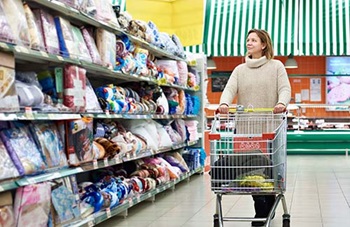By: Tom Duffy, Senior Advisor, Industry Relations, FMI

Shopping has always been personal for consumers, who have been making lists and choosing relevant items since, well, the first stores opened. Today, though, the possibilities of personalization span the entire shopping experience and lead to true one-on-one engagement.
Custom journeys are the route to retail success in the current and future marketplace, agrees Bill Wolfenden, vice president of sales of the grocery and alternate channel business at consumer health company Haleon whose purpose is to Deliver Better Everyday Health With Humanity through brands like TUMS, Sensodyne, Advil and Centrum.
“Personalization has been evolving for 20 years. Over the past few years, shoppers and consumers have gone from expecting and appreciating personalized offers on items they have historically purchased to expecting retailers and service providers to provide a fully personalized experience built around their overall needs and wants for any purchase modality they choose,” he said, adding that retailers can tap into needs in meaningful ways. “Personalization lets you get into the emotional space.”
Better, broader data and advanced technologies such as AI are helping to make this once-lofty strategy easier. “The nature of the always-connected shopper has created ecosystems of insight which allow retailers and media to connect in timely and relevant ways,” Wolfenden points out, adding that the acceleration of digital adoption during the COVID-19 pandemic has fueled a climate of change.
What does that personalized experience look like, especially since each customer’s journey is so inherently different? Wolfenden offered some insights on how to deliver relevance:
Leverage the tech possibilities
As companies invest in AI and retail media networks, they can use those tools to provide content and drive engagement. Some retailers are getting creative in making online businesses truly personal, like integrating symptom selectors on their health and wellness and pharmacy digital pages or matching nutrition supplement needs to a particular individual’s wellness goals.
Be considerate
Consideration, in this sense, applies to an understanding of shoppers’ lives. For example, during cough and cold season, instead of offering coupons for cough syrup based on past purchase history, a food retailer could help shoppers curate their experience in the omnichannel by offering suggestions for medicine, plus immune health supplements, hand sanitizer, cleaning wipes and even chicken soup. Buying behavior can also be analyzed for better engagement, like connecting with a shopper who is taking care of a young family as well as an aging parent and would appreciate suggestions and offers relating to the different aspects of their life.
Rethink traditional tools in digital forms
Digital circulars are one opportunity for retailers to help shoppers curate their trip and lead them to spaces where they may not usually go to in the physical store, including nonfood areas. “Even the smallest regional players can have digital circulars that cue up relevant information,” Wolfenden says, adding, “The path to purchase still often starts with a list.”
Tap into social platforms and people
Social selling and influencer partnerships are emerging spaces of potential growth as consumers seek to connect more with “people like me.”
Find the time and place for everything
Localization goes hand in hand with personalization. Perhaps it’s an 85-degree day in Boston during a springtime bloom, and a shopper could use sunscreen as well as over-the-counter allergy medicine. “If it’s raining tomorrow, they are in a whole different personalized situation,” points out Wolfenden, underscoring the possible benefits of geofencing technologies to take relevance to the next level.
However, retailers use AI and other technologies to make experiences highly individualized, they remain cognizant of privacy. “You have to be mindful and ethical, which I think all of our people are, and present it in a way that is a total solution and at a measured level,” Wolfenden says.
Finally, he emphasizes metrics to assess whether efforts to provide more personalized experiences are helping grow the shopper base, retain customers, garner responses to promotions and, of course, lift sales. “It’s really about engagement’,” Wolfenden concludes. “And no one is better at building engagement than grocers.”
Nonfood leaders are coming together June 13 – 15 for an interactive and immersive event focused on a shopper’s transition from impulse to loyalty within nonfoods categories such as, general merchandise, household and health and beauty care. Learn more at FMI Nonfoods Event.


 Industry Topics address your specific area of expertise with resources, reports, events and more.
Industry Topics address your specific area of expertise with resources, reports, events and more.
 Our Research covers consumer behavior and retail operation benchmarks so you can make informed business decisions.
Our Research covers consumer behavior and retail operation benchmarks so you can make informed business decisions.
 Events and Education including online and in-person help you advance your food retail career.
Events and Education including online and in-person help you advance your food retail career.
 Food Safety training, resources and guidance that help you create a company food safety culture.
Food Safety training, resources and guidance that help you create a company food safety culture.
 Government Affairs work — federal and state — on the latest food industry policy, regulatory and legislative issues.
Government Affairs work — federal and state — on the latest food industry policy, regulatory and legislative issues.
 Get Involved. From industry awards to newsletters and committees, these resources help you take advantage of your membership.
Get Involved. From industry awards to newsletters and committees, these resources help you take advantage of your membership.
 Best practices, guidance documents, infographics, signage and more for the food industry on the COVID-19 pandemic.
Best practices, guidance documents, infographics, signage and more for the food industry on the COVID-19 pandemic.
